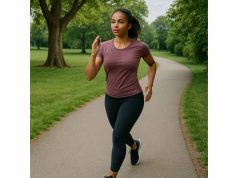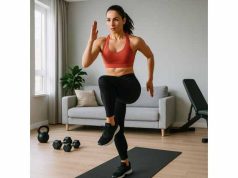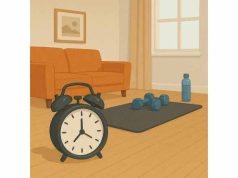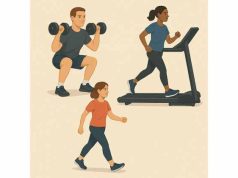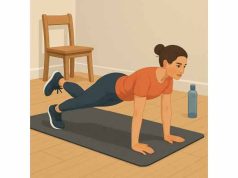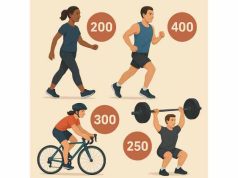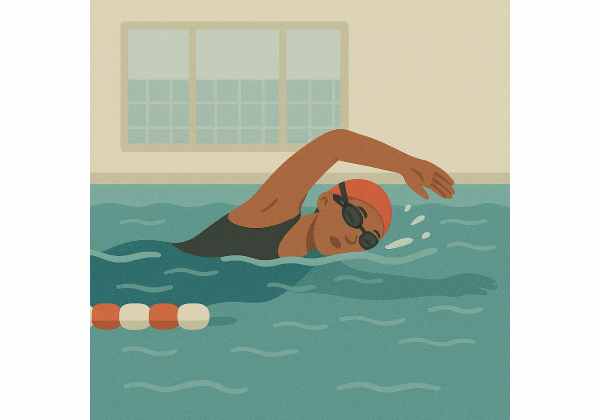
Swimming is a joint-friendly way to burn meaningful calories, build aerobic fitness, and feel better session by session. The water supports your body while demanding full-body work from your legs, hips, back, shoulders, and core. That combination makes swimming ideal when you want consistent training without the pounding of high-impact cardio. This guide gives you technique cues that actually help, interval formats that translate to fat loss, and an eight-week weekly plan for beginners. You will also learn how to pace your swims, progress safely, and blend strength and mobility so your shoulders stay happy. For a broader view of how cardio, lifting, and steps fit together in a sustainable plan, see our exercise framework for weight loss.
Table of Contents
- Why swimming for weight loss works
- Technique and pacing basics
- Beginner sets and drills
- Eight-week swim plan
- Injury prevention and fixes
- Strength and dryland support
- Troubleshooting and progression
- Frequently Asked Questions
Why swimming for weight loss works
Swimming supports weight loss because it checks the boxes that matter: full-body muscle recruitment, scalable intensity, low orthopedic cost, and built-in feedback on pacing and breathing. A steady freestyle set engages the hips, quads, hamstrings, lats, and mid-back while your core holds a long, stable body line. That widespread demand increases energy expenditure without stressing your joints like high-impact cardio.
You control intensity with simple levers—pace per 100 m/yd, stroke rate, and rest between repeats. Those variables let you target easy base work or short, faster intervals. Because pace is visible on the pool clock (or watch), progress is easy to track: your repeats get a touch faster at the same effort, or you hold the same pace with shorter rest.
Water makes consistency realistic. The buoyancy reduces ground reaction forces; the cool environment moderates heat stress; and the rhythm of breathing every 2–3 strokes creates natural pacing. For many beginners, that means fewer flare-ups and more total weekly minutes—arguably the most important metric for fat loss.
Swimming also complements daily life. Short 20–30 minute sessions fit into hectic weeks; longer aerobic days anchor the weekend. If you already walk or lift, swimming slides into the plan as either a primary cardio choice or a recovery-friendly cross-training day.
To make the most of it, keep most of your volume at a conversational effort (steady, controlled breathing) and sprinkle in one faster session weekly. Pair those swims with two brief strength sessions and a consistent step count. For safe rate-of-change guidelines and broader habit strategies, review our safe weight-loss basics and then return here to build your first eight weeks in the water.
Key takeaways
- Full-body work with low impact = higher weekly volume you can sustain.
- Pace, stroke rhythm, and rest make intensity adjustable and measurable.
- Consistency beats hero workouts; easy minutes done often drive outcomes.
- Light strength training and steps multiply swimming’s effect on fat loss.
Technique and pacing basics
You do not need elite mechanics to lose weight with swimming, but sound basics protect your shoulders and make every lap count. Think long body line, quiet kick, and a front-loaded stroke that anchors the hand before you pull.
Body position and kick
- Head and spine: Look slightly down and forward; keep the neck long. A high head sinks the hips and costs speed.
- Hips and legs: Aim for a straight line from head to heel. Use a small, steady flutter kick from the hips with relaxed ankles—think “boil the water,” not “fight it.”
- Rotation: Roll the body as one unit around the spine ~30–40° each side. Rotation lets you reach forward without shrugging the shoulder.
Freestyle pull and breath
- Entry: Fingertips enter in line with the shoulder, not crossing the midline.
- Catch: Set the forearm vertical early (“high elbow”) so you press water back, not down.
- Pull: Drive the hand under the body toward the hip; avoid a wide S-curve.
- Breath: Exhale gently underwater; inhale quickly as you roll. Bilateral breathing (every 3 strokes) is useful for balance, but breathing every 2 can be fine when effort rises.
Pacing without gadgets
- RPE: Keep most laps at RPE 3–5/10 (steady). Faster repeats reach RPE 7–8.
- Talk test (pool version): Between repeats, you should be able to say a full sentence within 10–15 seconds.
- Simple timing: Use the big pace clock. Start repeats “on the top” (:00), “on the bottom” (:30), or on a consistent send-off (e.g., every 2:10 for 100s).
Session scaffolding
- Warm-up (6–10 min): Easy swim + drills.
- Main set (15–30 min): Repeats or continuous aerobic work.
- Cool-down (4–6 min): Easy swim or backstroke to relax shoulders.
Effort zones in the pool
- Easy aerobic (Zone 2): Smooth breathing, long strokes, negative-split sets.
- Steady/tempo: Controlled discomfort; you can maintain form for 10–20 minutes worth of repeats.
- Short intervals: 25–100 repeats at strong but repeatable effort, plenty of rest.
If you like a structured approach to heart-rate and conversational-effort training, see our primer on Zone 2 cardio and apply the same principles to the water.
Tools that help (used sparingly)
- Pull buoy: Teaches body line; avoid overuse.
- Fins: Useful for kick endurance and ankle mobility; pick soft fins.
- Snorkel: Helps focus on catch without breath timing.
- Paddles: Build feel and strength once technique is consistent; choose small sizes and stop if shoulder discomfort appears.
Beginner sets and drills
The right drills sharpen form without overwhelming you, and simple sets let you accumulate useful minutes. Keep rest generous at first so technique stays intact.
Technique drills (pick 2 per session, 2–3 × 25–50 each)
- 6-3-6 kick-drill: Six kicks on left side, three strokes, six kicks on right. Focus on long spine and quiet head.
- Catch-up: One arm waits extended until the other finishes the pull. Teaches timing and clean entry.
- Fingertip drag: Lightly graze the water during recovery to encourage high elbows.
- Scull #1 (front): Small in-out sweeps with the forearms vertical to feel early catch pressure.
- Single-arm freestyle (with snorkel if needed): Emphasize body rotation and early catch.
Aerobic base sets (choose 1)
- 12 × 50 easy @ :15–:20 rest. Focus on long strokes; try to hold even times.
- 6 × 100 easy @ :20–:30 rest. If form fades, switch to 8 × 75.
- Continuous 12–20 minutes at smooth pace; breathe every 3–5 strokes as able.
Introductory interval sets
- 10 × 25 steady-hard @ :20–:30 rest. Aim for consistent times; full recovery between repeats.
- 8 × 50 build (each 50 starts easy, finishes strong) @ :20 rest.
- 4 × (75 steady + 25 strong) @ :25 rest after each 100.
Tempo/threshold sampler
Use once weekly after 2–3 weeks of base work:
- 3 × 200 steady @ :30 rest, hold the same pace each 200.
- Ladder: 50–75–100–75–50 steady with :20 rest throughout.
Kick and backstroke (sprinkle weekly)
- 4 × 50 kick (with or without board) @ :20–:30 rest; keep effort moderate.
- Easy backstroke between freestyle sets to relax the front of the shoulders.
Intervals are a tool, not the entire plan. Most weight-loss progress comes from steady minutes you can repeat. For context on how to balance faster work with longer easy sets, see our overview comparing intervals and steady-state cardio.
Beginner set builder (plug-and-play, ~30–40 min)
- Warm-up: 200 easy choice (mix strokes) + 4 × 25 drill (two drills).
- Main: Pick one base set and one introductory interval set from above.
- Cool-down: 100–200 easy, mostly backstroke.
Hold technique above ego. If your last rep is >3–4 seconds slower than the first at the same distance, end the set or add rest.
Eight-week swim plan
This plan builds from short repeats to longer steady blocks while protecting shoulders and energy. It assumes a 25 m or 25 yd pool; treat distances interchangeably and focus on time, effort, and repeatability. Swim 3 days/week on non-consecutive days.
Global rules
- Most minutes = easy aerobic (conversational between repeats).
- One day weekly includes controlled faster work.
- If soreness or life stress spikes, repeat the week or reduce volume by 20–30%.
- Warm up 6–10 minutes and cool down 4–6 minutes every session.
Weeks 1–2
- Day A (technique + base): 8 × 25 drill (alt. two drills) @ :20 rest; 8 × 50 easy @ :20.
- Day B (base): 3 × 100 easy @ :30, 4 × 50 easy @ :20, 200 easy continuous.
- Day C (intro speed): 10 × 25 steady-hard @ :25; 6 × 25 easy with focus on long strokes.
Weeks 3–4
- Day A: 6 × 50 drill/swim by 25 @ :20; 6 × 75 easy @ :20–:25.
- Day B: 12–16 minutes continuous easy; finish with 4 × 25 build @ :20.
- Day C: 6 × 50 strong @ :25; 4 × 50 easy @ :20.
Weeks 5–6
- Day A: 4 × 50 drill/swim; Main: 4 × 100 steady @ :25–:30.
- Day B: 20 minutes continuous easy (negative split the last 5).
- Day C: 3 × (4 × 50 @ :20) — #1 easy, #2 build, #3 strong, #4 easy; 100 easy.
Weeks 7–8
- Day A: 3 × 200 steady @ :30; 4 × 25 drill @ :20.
- Day B: 24 minutes continuous easy or 2 × 12 minutes with 2 minutes easy between.
- Day C: Ladder 50–75–100–75–50 @ :20; hold form; finish 4 × 25 backstroke easy.
Optional test (end of Week 8): Swim a continuous 500 at steady effort or 6 × 100 with :20 rest, aiming for even splits. Record average pace to guide future sets.
Hard days should not cluster. If you’re adding land training or long walks, space harder swims away from heavy lower-body strength. For more on scheduling lighter weeks and rest frequency, see our guide to planning rest days.
Injury prevention and fixes
Most beginner swim aches trace back to technique drift and enthusiasm outrunning shoulder capacity. A few habits reduce risk while keeping progress steady.
Before you swim (5–7 minutes)
- Scap prep: Band pull-aparts 2 × 12; shoulder external rotations 2 × 10/side.
- T-spine mobility: Open-book rotations 5/side; gentle cat-cow.
- Ankles and hips: 30–60 seconds of ankle rocks and hip openers.
- First 200 in water: Easy, varied strokes + two drills.
Technique checks that protect shoulders
- Enter and pull in line with the shoulder; avoid crossing midline.
- Set the early vertical forearm (feel pressure on forearm and hand).
- Keep the elbow above the wrist during the catch; do not press straight down.
- Rotate from the trunk, not by cranking the neck. Keep breath quick and quiet.
Common hotspots and quick fixes
- Front-of-shoulder pinch: Shrugging on entry. Soften the hand, spear forward slightly down, and lengthen the body line. Reduce paddle work temporarily.
- Neck tension: Looking forward. Tuck the chin lightly; look down and forward; breathe with body rotation.
- Low-back ache: Swayback or excessive kick. Brace the ribs down gently; kick from the hips with a smaller amplitude.
Load management
- Increase total weekly meters/minutes by no more than 10–15%.
- Every 3–4 weeks, cut volume by ~20–30% for a lighter week.
- If pain is sharp, localized, or persists into daily life, stop and consult a clinician before resuming.
For a simple pre-swim warm-up and recovery sequence you can reuse for other training days, see our warm-up and mobility guide.
Strength and dryland support
Dryland work preserves muscle during weight loss, builds robust shoulders, and improves your ability to hold a long body line in the water. You do not need long gym sessions—20–35 minutes, two days per week covers the essentials.
Movement menu (pick 1–2 per category)
- Push: Elevated push-ups, dumbbell floor press.
- Pull: One-arm dumbbell row, chest-supported row, banded pull-downs.
- Hinge: Romanian deadlift, hip thrust.
- Squat/split: Goblet squat, split squat, step-ups.
- Core (anti-extension/rotation): Dead bug, hollow hold progressions, suitcase carry.
- Shoulder stability: Band external rotations (elbow by side), Y-T-W raises, face pulls.
Sample 30-minute circuit (2–3 rounds)
- Goblet squat 8–10
- One-arm row 8–12/side
- DB floor press 8–10
- RDL 8–10
- Band pull-apart 12–15
- Dead bug 6–10/side
Rest 45–75 seconds between moves; leave 1–2 reps in reserve most sets. Place dryland on days you do easy swims or the day before a rest day.
A bit of targeted core work also supports body position and breathing rhythm in the pool. For more ideas that pair well with swimming, see our guide to core training while losing weight.
Troubleshooting and progression
When progress stalls, the causes are usually simple: not enough easy volume to build the base, too much “kind-of-hard” work, or technique decay from rushing rest. Use the steps below to nudge results without burnout.
If weight loss plateaus
- Audit steps and NEAT: Swimming can make you sit more. Re-establish a daily step target.
- Tighten intake on training days: Aim for consistent meals with protein and produce; avoid grazing post-swim out of habit.
- Sleep: Protect 7–8 hours; poor sleep blunts training quality and appetite control.
If paces stagnate
- Extend one easy swim by 3–5 minutes weekly until you reach 30–40 minutes continuous.
- Add short pickups inside an easy session: 6 × 25 strong with full recovery.
- Technique blocks: Insert 8–10 minutes of focused drills mid-session to reset form before resuming base work.
Simple progress rules
- Change one lever at a time: add a repeat, shave a few seconds of rest, or hold pace at a lower RPE.
- Track a benchmark set every 2–3 weeks (e.g., 6 × 100 @ :20 rest) and record average time.
- Keep faster days separated by at least 48 hours until your shoulders feel bomb-proof.
Mindset for the long game
- Treat swimming like skill practice: long body line, calm breath, patient pacing.
- Celebrate consistency: three honest sessions, two short walks, and decent sleep often beat any “perfect” workout.
- Repeat weeks when needed—repetition consolidates technique and confidence.
Frequently Asked Questions
How many times per week should I swim to lose weight?
Three days per week works well for most beginners. It balances adaptation with recovery and fits alongside steps and two short strength sessions. Add a fourth easy day only when shoulders feel great and you’re sleeping well.
Is freestyle the best stroke for fat loss?
Freestyle is the most efficient for longer sets and easier to progress. Backstroke is excellent for shoulder comfort and recovery between freestyle repeats. Breaststroke can stress knees for some athletes; use sparingly if you have a history of knee pain.
How long should a beginner swim workout be?
Thirty to forty minutes including warm-up and cool-down is plenty at first. Keep most of the main set at an easy, repeatable pace. As fitness improves, extend one session to 45–50 minutes or add repeats to existing sets.
Will swimming build muscle or only burn calories?
Swimming primarily develops aerobic capacity and muscular endurance. It can strengthen the upper back and core, but substantial muscle gain usually requires dryland strength work. Pair two short lifting sessions weekly with your swims to preserve lean mass during weight loss.
What equipment do I actually need?
A comfortable pair of goggles, a swim cap (if you have longer hair), and a swimsuit that stays put. Optional tools—pull buoy, fins, small paddles, and a snorkel—can help with drills but are not required for weight loss.
How do I pace my intervals without a watch?
Use the pool clock. Start each repeat on a consistent send-off (e.g., every 2:10 for 100s). Try to finish with 10–20 seconds to spare. If you cannot hold even times, add rest or shorten the repeat distance so technique stays clean.
Can I lose weight with water jogging or kickboard work?
Yes. Deep-water running and kick sets are low-impact ways to raise heart rate and add minutes, especially during return-to-run phases or when your shoulders need a lighter day. Treat them like aerobic base work at a steady, conversational effort.
References
- Effects of water aerobics on body composition in obesity and overweight people: a systematic review and meta-analysis 2025. (Systematic Review & Meta-analysis)
- Aerobic Exercise and Weight Loss in Adults: A Systematic Review and Dose-Response Meta-Analysis 2024. (Systematic Review & Meta-analysis)
- Shoulder pain and injury risk factors in competitive swimmers: A systematic review 2023. (Systematic Review)
- The effect of aquatic High Intensity Interval Training on cardiometabolic and physical health markers in women: A systematic review and meta-analysis 2022. (Systematic Review & Meta-analysis)
- WHO guidelines on physical activity and sedentary behaviour 2020. (Guideline)
Disclaimer
This article is educational and is not a substitute for personalized medical advice. Speak with your physician or a qualified health professional before starting a new exercise or nutrition plan—especially if you have cardiovascular, metabolic, or orthopedic conditions, are pregnant, or are returning from injury or surgery.
If this guide helped you, consider sharing it with a friend. You are welcome to follow us on Facebook or X for straightforward training ideas, weekly templates, and updates grounded in evidence.

